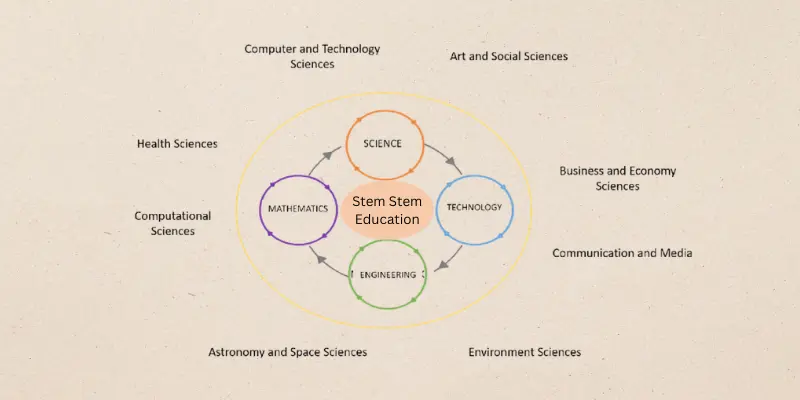Stem stem education is not just a buzzword it is the backbone of future learning. In a world shaped by technology and rapid change, students need more than memorized facts; they need the power to think, build, explore, and solve. That’s exactly what STEM education delivers. By blending Science, Technology, Engineering, and Mathematics into real-world learning, STEM unlocks curiosity and empowers young minds to become tomorrow’s creators and innovators. Whether in classrooms, labs, or even home-based projects, STEM is shaping the skills that matter most in the 21st century.
Key Elements of Effective STEM Learning In Stem Stem Education
Stem stem education works best when it is built around curiosity, creativity, and real problem-solving. It is not just about learning facts it is about doing, testing, failing, and trying again. A strong stem environment makes learning exciting and meaningful for every student. Here are a few essential elements that make stem learning truly effective:

- Hands-On Exploration: Kids learn more when they build, experiment, and explore with real materials instead of only reading books.
- Team-Based Challenges: Working in groups teaches collaboration, communication, and critical thinking all key life skills.
- Integrated Subjects: Instead of teaching science or math separately, stem blends all four subjects into one creative process.
- Freedom to Fail: Mistakes are seen as learning moments. This helps students become confident and independent thinkers.
STEM stem education isn’t about perfect answers it’s about brave questions, smart teamwork, and making ideas real.
Setting Up A STEM Classroom Of Education
STEM stem education begins with creating the right space one that inspires hands-on learning, teamwork, and creativity. A strong stem classroom isn’t defined by expensive tools but by an environment that encourages students to ask questions, explore ideas, and build real solutions. From arranging flexible seating to using low-cost materials like cardboard, string, or simple circuits, even the smallest changes can spark big curiosity. What matters most is a mindset of experimentation, where students feel safe to try, fail, and try again.
You may also visit this link: My Education Data
Smart Strategies To Improve STEM Learning
Stem stem education becomes more powerful when we focus not just on what we teach but how we teach it. Making learning more fun, inclusive, and real-world based can help every child feel connected to science, technology, engineering, and math. Here are some smart ways to make STEM learning better:

1. Blend Art with STEM
Adding art brings creativity to science and helps students express ideas in new ways.
2. Use Local Problems
Let students solve issues from their own community it feels more real and makes learning meaningful.
3. Train Teachers Well
When educators are confident with STEM tools and ideas, students learn with more energy and curiosity.
4. Encourage Questions
Let students ask “why” and “how” often this builds critical thinking naturally.
5. Make Learning Playful
Games, simple robots, and fun challenges keep students engaged and excited to learn.
With the right mindset and these simple strategies, STEM stem education can truly inspire the next generation of problem solvers and inventors.
You may also visit this link: Aitkin Community Education
Benefits of STEM STEM Education
STEM stem education doesn’t just teach students new subjects it builds skills that last a lifetime. It helps learners think deeper, ask better questions, and find smarter solutions in everyday life.
| Pros of STEM STEM EDUCATION |
| Prepares for Future Jobs: Most modern careers need skills in tech, science, or critical thinking. |
| Boosts Creativity: STEM encourages imagination through hands-on experiments and inventions. |
| Builds Confidence: Trying and failing and trying again teaches students to believe in their own ideas. |
| Real-World Problem Solving: Students learn how to face real challenges by thinking, testing, and creating. |
| Encourages Teamwork: STEM activities often include group work, which improves communication and leadership. |
Challenges Of STEM STEM Education
STEM stem education offers big opportunities, but also faces some real challenges especially in schools that are still trying to adapt. These hurdles can slow down progress if not addressed with care and creativity.
| Challenges Of STEM STEM Education |
| Time Constraints: With packed schedules, teachers may struggle to fit in creative STEM projects. |
| Outdated Teaching Styles: Some classrooms still focus on memorization instead of hands-on discovery. |
| Limited Access: Not all students, especially in rural or low-income areas, get the same STEM opportunities. |
| Lack of Resources: Many schools don’t have enough tools, lab equipment, or trained teachers to support STEM learning. |
| Gender Gaps: Girls are often underrepresented in tech and engineering activities due to stereotypes or lack of encouragement. |
Common FAQs About STEM STEM Education
STEM STEM education often raises important questions for parents, teachers, and even students. Here are some quick answers to the most common ones:
What does STEM really stand for?
STEM means Science, Technology, Engineering, and Mathematics. It blends these subjects to help students learn by doing.
Why is STEM education important today?
It builds skills like problem-solving, critical thinking, and creativity skills that are needed in today’s fast-changing world.
Can young kids learn STEM?
Yes, Even early learners can explore basic STEM ideas through fun activities like building, counting, or asking “why.”
Is STEM only for future scientists?
Not at all. STEM teaches everyday thinking skills that help in any career whether it’s business, design, teaching, or engineering.
How can schools start STEM programs?
They can begin with simple projects, train teachers, and use low-cost materials to encourage hands-on learning.
Conclusion
STEM STEM education is more than just learning science or math it’s about building the skills to think, create, and solve real problems. It gives students the tools to shape their future with confidence and creativity. Whether in classrooms or at home, encouraging STEM thinking means encouraging lifelong learning. The earlier we start, the stronger and smarter our next generation will be.
Written by: Rank Guruji






